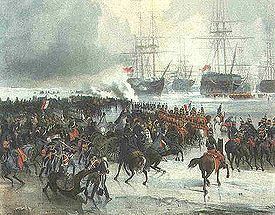14 warships (850 guns), and several merchant ships captured None Location Wadden Sea | Date 23 January 1795 | |
 | ||
14 warships850 guns in total One hussar regimentOne infantry battalion Similar First Battle of Dego, Battle of the Black Mountain, Battle of Mainz, Battle of Sprimont, Siege of Valenciennes | ||
The Capture of the Dutch fleet at Den Helder or the Battle of Texel occurred in the night of the 23 January 1795, and presents a rare occurrence of a "naval" battle between warships and cavalry, in which a French Hussar regiment surprised a Dutch fleet frozen at anchor between the port of Den Helder and the island of Texel. After an extraordinary charge across the frozen Zuiderzee, the French cavalry captured 14 Dutch ships and 850 guns. A capture of ships by horsemen is an extremely rare feat in military history. However, some sources say that no battle actually took place, and that the French Hussars merely accepted a previously agreed-upon surrender of the Dutch fleet.
Contents
The French units were the 8th Hussar Regiment and the 15th Line Infantry Regiment of the French Revolutionary Army. Jean-Charles Pichegru was the leader of the French army that invaded the Dutch Republic. The Dutch fleet was commanded by H. Reintjes. The actual capture was accomplished by Jean-Guillaume de Winter and Louis Joseph Lahure. The action happened during the War of the First Coalition, part of the French Revolutionary Wars.
Background
Den Helder is located at the tip of the North Holland peninsula, south of the island of Texel, on what was then the shallow Zuiderzee bay (Dutch for Southern Sea ; cf North Sea). The Zuiderzee has been closed off and partly pumped out in the 20th century, and what is left of it now forms the freshwater IJsselmeer.
During the War of the First Coalition of the French Revolutionary Wars, General of Division Jean-Charles Pichegru was commanding the autumn 1794 campaign during which the conquest of the Netherlands occurred. The French Army entered Amsterdam on the 19 January 1795 to stay there over winter. Well informed, the general found out that a Dutch fleet was anchored at Den Helder, approximately eighty kilometers north from Amsterdam.
The winter of 1794–1795 was exceptionally cold, causing the Zuiderzee to freeze.
Pichegru ordered General of Brigade Jean-Guillaume de Winter to lead a squadron of the 8th Hussar. De Winter had been serving with the French since 1787, and would later command the Dutch fleet in the Battle of Camperdown.
Capture
General de Winter arrived at Den Helder with his troops during the night of the 23 January 1795. The Dutch fleet was there as expected, trapped by ice. Each hussar had brought on the croup of his horse an infantryman of the 15th Line Infantry Regiment. After a careful approach to avoid awakening the Dutch sailors (the hussars had covered the horses' hooves with fabric), Lieutenant-Colonel Louis Joseph Lahure launched the assault. The ice did not break, and the hussars and infantrymen were able to board the Dutch ships. The French captured the Dutch admiral and the vessels' crews; the French suffered no casualties.
Dispute over historicity
The traditional narrative of French cavalry storming and capturing the ships at Den Helder is primarily based off French sources. However, the Dutch historian Johannes de Jonge claimed that the Dutch fleet had already received orders on the 21st of January to offer no resistance. Instead, some French hussars merely crossed the ice for a meeting with the Dutch officers to negotiate a handover, contributing to later myth. The legend of a capture on the ice is likely based on an 1819 publication by the Swiss general Antoine-Henri Jomini.
Results
The capture completed, the French conquest of the Netherlands was brought to an end and the French Army captured 14 warships, 850 guns, and several merchant ships. It is one of the only times in recorded military history wherein cavalry captured a fleet, (José Antonio Páez's 1818 cavalry attack across the Apure River being another).
Prizes
The ships of the line, frigates, and corvettes received French crews in February 1795. France returned all her prizes to the Batavian Republic in May 1795 against a payment of 100 million Florins.
Post script
In the Vlieter Incident on 30 August 1799, a squadron of the navy of the Batavian Republic under the command of Rear-Admiral Samuel Story surrendered to the British Royal Navy. The incident occurred during the Anglo-Russian Invasion of Holland. It took place on a sandbank near the channel between Texel and the mainland that was known as De Vlieter, near Wieringen. Two of the vessels the British seized were Admiral de Ruyter and Gelderland.
